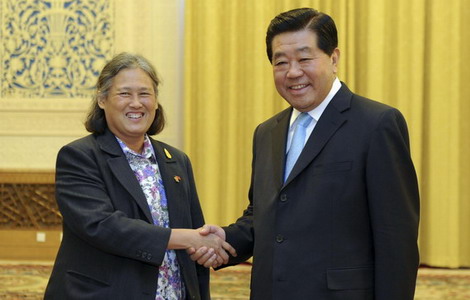 |
|
|
|
|||||||||||
The HSBC's China Services Purchasing Managers Index (PMI) for March stood at 53.3, signaling another expansion of the services sector. But the reading was down slightly from 53.9 in February, and is still below its long-term average of 56.7, suggesting that pro-growth policy support remains necessary.
Qu Hongbin, HSBC's Hong Kong-based chief economist for China, said that overall economic growth appeared to be losing its momentum, whether in export orders, industrial production, or employment.
"The risk of an economic slowdown is still the focus of current policy," Qu said.
"Although surging oil prices are pushing up prices in the service sector, overall inflationary pressure is still under control because of slow economic growth," he said, adding that further easing measures are needed to restore growth in the future.
Headquartered in London, HSBC is one of the world's largest banking and financial services conglomerates. The HSBC Services PMI is compiled by Markit, a UK-based data provider.
The index was published two days after China's official non-manufacturing PMI weighed in at 58 for March, up from a revised February figure of 57.3 after seasonal corrections.
A PMI reading below 50 indicates contracting activity, while a reading above 50 shows expansion.
While the headline index and various component parts revealed steady growth, the data also showed the weakest jobs growth in the service sector in 38 months.
This echoed the HSBC PMI in March, another key economic indicator of business activity in the manufacturing sector, which dropped 1.3 points from the previous month, though the official PMI was up 2.1 points to 53.1.
As a result, the comprehensive HSBC PMI, which combined the manufacturing and service sectors, plunged to 49.9.
The figures reflect activity at China's big factories in March, as a stream of new orders lifted activity to an 11-month high, but also difficulties for credit-constrained smaller manufacturers.
The pickup in production at large factories was attributed to an expected bump as winter ends. Economists cautioned some easing of monetary policy will be required this year to ensure a soft landing.
China's growth has slowed for four successive quarters. Economists say economic expansion has cooled to just above 8 percent in the first three months of 2012, putting the country on track for its slowest growth for a full year in at least a decade.
Despite the cautions, respondents to the PMI were clearly upbeat on the outlook for business over the coming 12 months, citing plans to expand their companies and reflecting the view that growth in the broad economy in China will accelerate.
Almost one-fifth of survey respondents said business had increased from a month earlier, while just 9 percent indicated a reduction, with the new business index reflecting an improvement in market conditions.
China's government has had economic policy settings on a pro-growth path since announcing a "fine-tuning" last autumn.
There have been two 50-basis point cuts to the requirement reserve ratio - the proportion of deposits banks must keep as reserves - to keep a steady growth of the money supply.
That policy easing appears to be gaining some traction in China's vast export-oriented manufacturing sector, stymied in the second half of 2011 by slack demand in its two biggest trading partners, the European Union and the United States.
Investors are gaining confidence that policymakers are working to avoid a hard landing in the world’s second largest economy.
A poll by Reuters in March showed analysts expect China's central bank to lower the ratio of cash banks must hold as reserves by another 150 basis points this year.

|

|

|

|

|

|